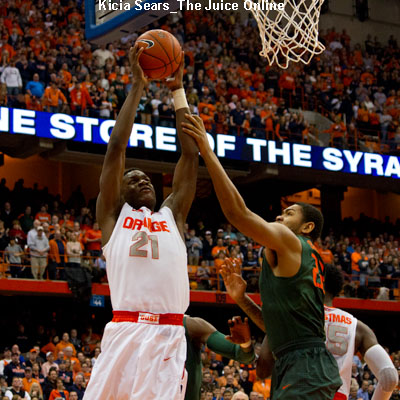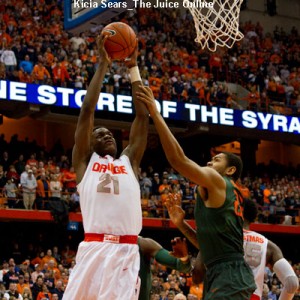

The Syracuse Orange basketball team will return four players in 2015-16 that started at least 19 games last season. Two fifth-year seniors, Trevor Cooney and Michael Gbinije, will anchor a starting lineup after averaging over 26 points per game combined last season. In large part, head coach Jim Boeheim knows what to expect from those two.
Boeheim can hope for improvements from rising sophomore Kaleb Joseph, who struggled in his freshman campaign. But, from what he has shown so far, Joseph may be capable of only modest increases in performance.
The wild card among the four? Tyler Roberson.
Perhaps more inconsistent, Roberson did show flashes of being a breakout player in his sophomore season. He had six double-doubles, including a 19-point, 10-rebound game against Duke, 16 points and 12 rebounds against NC State in the season finale and two games where he grabbed 17 rebounds.
After averaging just 2.2 points and 1.9 rebounds in his freshman season, Roberson elevated those numbers to 8.3 points and 7.3 rebounds last season.
But what can be reasonably expected out of Roberson in his junior year?
A look back at the last 10 years, there have been a slew of Syracuse forwards who have stayed at least three seasons and enjoyed varying degrees of improvements from their sophomore to junior seasons. The list: Rakeem Christmas, C.J. Fair, James Southerland, Kris Joseph, Rick Jackson, Demetris Nichols, Terrence Roberts and Hakim Warrick.
In general, all the guys showed improvement. Southerland and Christmas showed just minimal improvements in their junior years before taking off in their senior campaigns. Jackson showed modest improvements each year at Syracuse, but never took great leaps in any one year.
» Related: 40 seasons of highs, lows in Syracuse coach Jim Boeheim’s career
Nichols, Joseph and Fair all took on much more of a scoring role in their third seasons.
Nichols more than tripled his scoring output, from 3.9 points per game to 13.3, thanks to 58 more made 3-point attempts and an 11-point increase in his 3-point percentage. Nichols followed that up with 18.9 points and 100 made 3-pointers in his senior season.
Joseph had already become a double-digit scorer in his sophomore season, but bumped his scoring average from 10.8 to 14.3 points a game in his junior season. Like Nichols, Joseph found his range in his third year, draining 45 3-pointers after sinking just 16 in his first two seasons combined.
Fair jumped six points per game (up to 14.5) in his junior season by, you guessed it, finding a 3-point shot. After just seven makes from beyond the arc in his first two seasons, he sank 30 in his junior year.
The previous three were all more small forwards than power forwards. The 3-point shot does not seem to be a part of Roberson’s game, nor does it appear it will become a part of his repertoire after attempting (and missing) eight 3-pointers in his first two seasons. But, as far as power forwards go, we can draw on a best-case scenario and worst-case scenario for Roberson to follow.
BEST CASE: Hakim Warrick. Warrick had a more productive freshman year than most of these guys, averaging over six points and almost five rebounds per game. His sophomore season? Better, too. He averaged 14.8 points and 8.5 rebounds. Like Roberson, Warrick did not stray too far from the basket, attempting just nine 3-pointers in his first three seasons total. But, he learned to become lethal from 18 feet and in, boosting his field goal percentage above 50 percent in his junior year and his scoring average to nearly 20 points per game. He maintained his rebounding in each of his junior and senior years, bumped his scoring up again to 21.4 points in his senior year on his way to the Big East Player of the Year award.
WORST CASE: Terrence Roberts. As athletic as he was, Roberts could just not put it all together. He started out much like Roberson, going from 2.1 points and 1.9 rebounds in his first year (compared to 2.2 points and 1.9 rebounds for Roberson). They both bumped up their points significantly in their second (7.2 for Roberts and 8.3 for Roberson). Roberts even became a 10-point scorer in his third season before dropping back to 8.9 points in his senior year. But, a poor basketball IQ mixed with a propensity for fouls made Roberts a disappointment in Central New York.
For Roberson, his scoring numbers have grown and will continue to grow if he can improve upon his 44 percent field goal percentage. His rebounding numbers have already become a strong point, with a chance to one day average a double-double if the trend continues.
But, what, perhaps, is lacking for Roberson is the opportunity to drastically improve his cumulative totals. With Cooney and Gbinije, Roberson is, at best, the third option offensively. If any of the freshman class assert themselves as a go-to option, Roberson will get fewer and fewer looks. His best shot to have a breakout season is to maintain his usage, while improving his rebound totals (which would, in turn, theoretically improve his field goal percentage and up his scoring).
While guys like Warrick, Nichols and Joseph became the No. 1 option on their teams, Roberson is not that guy. He’s a complementary offensive piece at this point, not the focal point. So, while he may not emerge like those guys did, he seems to have the motor, work ethic and talent to continue to be an asset. He’s not a Terrence Roberts, but not a Hakim Warrick.
Maybe Roberson will fall more in line with a balance between Christmas’ junior and senior seasons: a 10-point, eight-rebound solid contributor for the Orange, with an outside chance at double-double potential. Would you sign up for that?
For more Syracuse coverage, Like our Facebook page and follow us @TheJuiceOnline.

